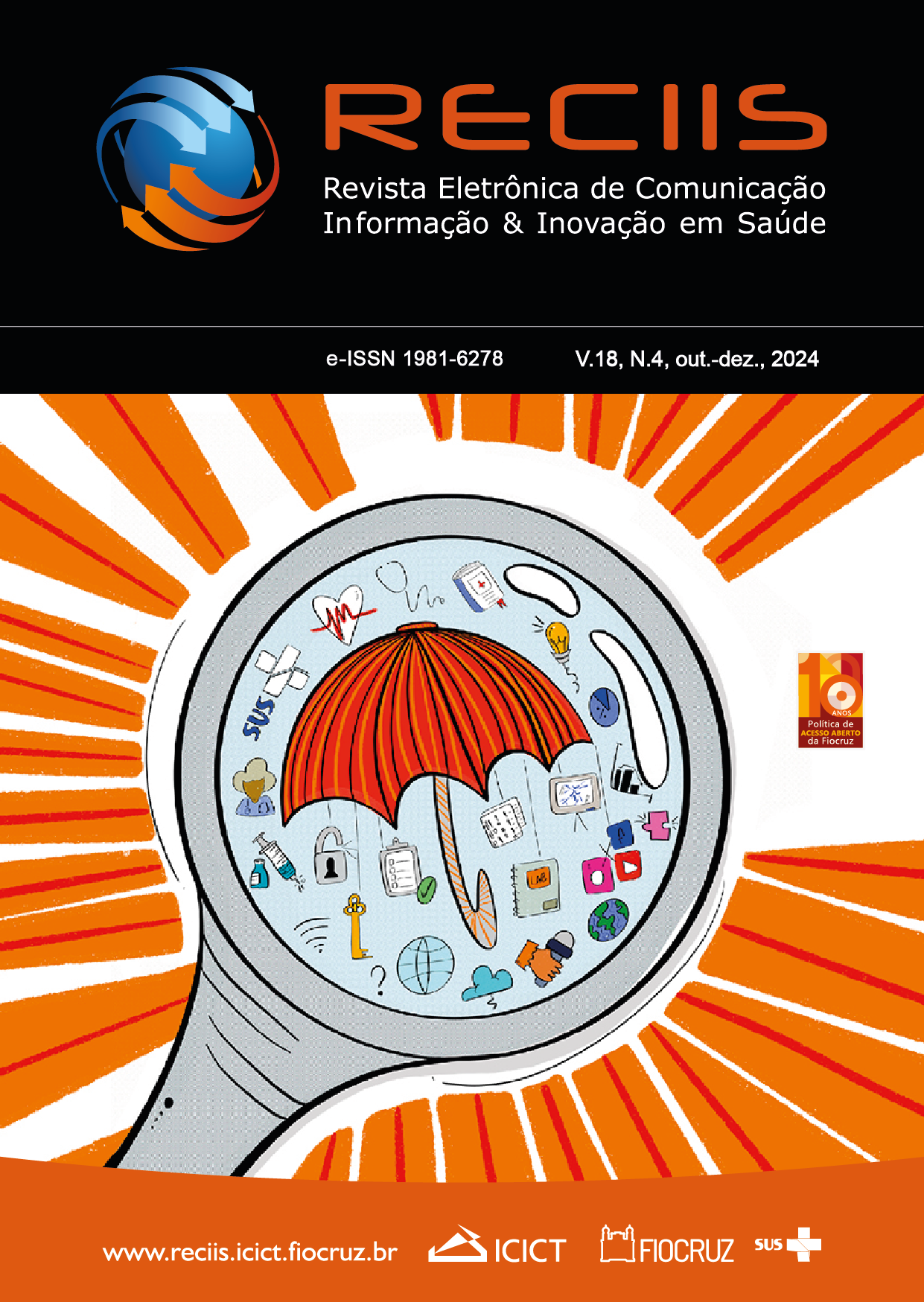Influencias del tiempo de pantalla en la calidad de vida de los niños
DOI:
https://doi.org/10.29397/reciis.v18i4.4088Palabras clave:
Medios audiovisuales, Tiempo de pantalla, Niño, Calidad de vida, Salud infantilResumen
Con el aumento del uso de pantallas en la población pediátrica, esta investigación tiene como objetivo evaluar la influencia del patrón de uso y el tiempo de pantalla en la calidad de vida de los niños. Se trata de un estudio observacional, transversal y analítico realizado con madres, padres y responsables de niños en edad preescolar (de 2 a 4 años) en una ciudad del noreste de Brasil, totalizando 198 niños. La recolección de datos se realizó mediante Google Forms y la calidad de vida se verificó mediante el instrumento PedsQL 4.0. La mayoría de los niños utiliza pantallas más de una hora al día (69,19%), por encima de lo recomendado por las entidades médicas. Se verificó la influencia del uso de medios digitales en la calidad de vida de los niños: peores patrones de uso se relacionaron con pérdidas en la salud física (p=0,012) y emocional (p entre 0,006 y 0,046). El elevado tiempo de pantalla se correlacionó con impactos en la esfera social de la vida del niño (p=0,043).
Citas
ABUD, Cristiane Curi; LUCCHESE, Ana Cecilia; ZIMMERMANN, Vera Blondina. A infância: introdução. In: MARCO, Mario Alfredo de et al. Psicologia médica: abordagem integral do processo saúde-doença. Porto Alegre: Artmed, 2012. p. 187-208.
AISHWORIYA, Ramkumar et al. Television viewing and child cognition in a longitudinal birth cohort in Singapore: the role of maternal factors. BMC Pediatrics, London, v. 19, n. 1, p. 1-8, 2019. DOI: https://doi.org/10.1186/s12887-019-1651-z. Disponível em: https://link.springer.com/article/10.1186/s12887-019-1651-z. Acesso em: 20 ago. 2023.
ALI, Reem Ahmad; ALMA’AYTAH, Maha Mohamed Deib. Correlates of parental knowledge about smartphone exposure among young children. Pediatrics International, Carlton South, v. 64, n. 1, 20 maio 2022. DOI: https://doi.org/10.1111/ped.15246. Disponível em: https://onlinelibrary.wiley.com/doi/10.1111/ped.15246. Acesso em: 26 ago. 2024.
BUCHWEITZ, Augusto. Desenvolvimento da linguagem e da leitura no cérebro atualmente: neuromarcadores e o caso de predição. Jornal de Pediatria, Porto Alegre, v. 92, n. 3, p. S8-S13, 2016. DOI: https://doi.org/10.1016/j.jped.2016.01.005. Disponível em: https://www.scielo.br/j/jped/a/QwDnRXppZGXHCzmVTTRFWzN/?lang=pt. Acesso em: 20 ago. 2023.
CENTRO REGIONAL DE ESTUDOS PARA O DESENVOLVIMENTO DA SOCIEDADE DA INFORMAÇÃO (CETIC.BR.). Núcleo de Informação e Coordenação do Ponto BR. Pesquisa TIC Kids Online Brasil 2022. São Paulo: Comitê Gestor da Internet do Brasil, 2023. E-book. Disponível em: https://cetic.br/pt/publicacao/pesquisa-sobre-o-uso-da-internet-por-criancas-e-adolescentes-no-brasil-tic-kids-online-brasil-2022/. Acesso em: 20 ago. 2023.
DESLANDES, Suely Ferreira; COUTINHO, Tiago. The intensive use of the internet by children and adolescents in the context of covid-19 and the risks for self-inflicted violence. Ciência e Saúde Coletiva, Rio de Janeiro, v. 25, p. 2479-2486, 2020. DOI: https://doi.org/10.1590/1413-81232020256.1.11472020. Disponível em: https://www.scielosp.org/article/csc/2020.v25suppl1/2479-2486/en/. Acesso em: 20 ago. 2023.
DOMOFF, Sarah E. et al. A naturalistic study of child and family screen media and mobile device use. Journal of Child and Family Studies, New York, v. 28, n. 2, p. 401-410, 2019. DOI: https://doi.org/10.1007/s10826-018-1275-1. Disponível em: https://link.springer.com/article/10.1007/s10826-018-1275-1. Acesso em: 20 ago. 2023.
DROUIN, Michelle et al. How parents and their children used social media and technology at the beginning of the covid-19 pandemic and associations with anxiety. Cyberpsychology, Behavior, and Social Networking, New Rochelle, v. 23, n. 11, p. 727-736, 2020. DOI: https://doi.org/10.1089/cyber.2020.0284. Disponível em: https://www.liebertpub.com/doi/abs/10.1089/CYBER.2020.0284. Acesso em: 20 ago. 2023.
FELIX, Erika et al. Excessive screen media use in preschoolers is associated with poor motor skills. Cyberpsychology, Behavior, and Social Networking, New Rochelle, v. 23, n. 6, p. 418-425, 2020. DOI: https://doi.org/10.1089/cyber.2019.0238. Disponível em: https://www.liebertpub.com/doi/abs/10.1089/cyber.2019.0238. Acesso em: 20 ago. 2023.
FERNANDES, Claudia Mascarenhas; EISENSTEIN, Evelyn; SILVA, Eduardo Jorge Custódio da. A criança de 0 a 3 anos e o mundo digital. Rio de Janeiro: Sociedade Brasileira de Pediatria, 2018. Disponível em: https://www.sbp.com.br/fileadmin/user_upload/A_CRIANCA_DE_0_A_3_ANOS_E_O_MUNDO_DIGITAL.pdf. Acesso em: 20 ago. 2023.
GUERRERO, Michelle D. et al. Screen time and problem behaviors in children: Exploring the mediating role of sleep duration. International Journal of Behavioral Nutrition and Physical Activity, [London], v. 16, n. 1, p. 1-10, 2019. DOI: https://doi.org/10.1186/s12966-019-0862-x. Disponível em: https://ijbnpa.biomedcentral.com/articles/10.1186/s12966-019-0862-x?fbclid=IwAR1WRGA7htl. Acesso em: 20 ago. 2023.
HUTTON, John S. et al. Associations between screen-based media use and brain white matter integrity in preschool-aged children. JAMA Pediatrics, Chicago, v. 174, n. 1, p. 1-10, 2019. DOI: https://doi.org/10.1001/jamapediatrics.2019.3869. Disponível em: https://jamanetwork.com/journals/jamapediatrics/fullarticle/2754101. Acesso em: 20 ago. 2023.
KERAI, Salima et al. Screen time and developmental health: results from an early childhood study in Canada. BMC Public Health, v. 22, p. 310, 2022. DOI: https://doi.org/10.1186/s12889-022-12701-3. Disponível em: https://bmcpublichealth.biomedcentral.com/articles/10.1186/s12889-022-12701-3. Acesso em: 21 ago. 2024.
KLIEGMAN, Robert M. et al. Nelson Tratado de Pediatria. 20. ed. Rio de Janeiro: Elsevier, 2018.
MADIGAN, Sheri et al. Association between screen time and children’s performance on a developmental screening test. JAMA Pediatrics, Chicago, v. 173, n. 3, p. 244-250, 2019. DOI: https://doi.org/10.1001/jamapediatrics.2018.5056. Disponível em: https://jamanetwork.com/journals/jamapediatrics/article-abstract/2722666. Acesso em: 20 ago. 2023.
MASSARONI, Valentina et al. The relationship between language and technology: how screen time affects language development in early life–a systematic review. Brain Sciences, Basel, v. 14, n. 1, p. 1-19, 2023. DOI: https://doi.org/10.3390/brainsci14010027. Disponível em: https://www.mdpi.com/2076-3425/14/1/27. Acesso em: 21 ago. 2024.
MATA, Ingrid Ribeiro Soares da et al. As implicações da pandemia da covid-19 na saúde mental e no comportamento das crianças. Residência Pediátrica, Rio de Janeiro, v. 10, n. 3, p. 1-5, 2020. Disponível em: https://residenciapediatrica.com.br/detalhes/643/as%20implicacoes%20da%20pandemia%20da%20covid-19%20na%20saude%20mental%20e%20no%20comportamento%20das%20criancas. Acesso em: 20 ago. 2023.
MOREIRA, Larissa Hora et al. Consequências do tempo de tela precoce no desenvolvimento infantil = Consequences of early screen time on child development. Brazilian Journal of Development, Paraná, v. 7, n. 10, p. 97125-97133, 14 out. 2021. DOI: https://doi.org/10.34117/bjdv7n10-156. Disponível em: https://ojs.brazilianjournals.com.br/ojs/index.php/BRJD/article/view/37372. Acesso em: 21 ago. 2024.
MOTAMED-GORJI, Nazgol et al. Association of screen time and physical activity with health-related quality of life in Iranian children and adolescents. Health and Quality of Life Outcomes, [London], v. 17, n. 1, p. 1-11, 2019. DOI: https://doi.org/10.1186/s12955-018-1071-z. Disponível em: https://hqlo.biomedcentral.com/articles/10.1186/s12955-018-1071-z. Acesso em: 20 ago. 2023.
MUNZER, Tiffany G. et al. Media exposure in low-income preschool-aged children is associated with multiple measures of self-regulatory behavior. Journal of Develeopmental Behavioral Pediatrics, Baltimore, v. 39, n. 4, p. 303-309, 2018. DOI: https://doi.org/10.1097/DBP.0000000000000560. Disponível em: https://journals.lww.com/jrnldbp/fulltext/2018/05000/media_exposure_in_low_income_preschool_aged.4.aspx. Acesso em: 20 ago. 2023.
NOBRE, Juliana Nogueira Pontes et al. Determining factors in children’s screen time in early childhood. Ciência e Saúde Coletiva, Rio de Janeiro, v. 26, n. 3, p. 1127-1136, 2021. DOI: https://doi.org/10.1590/1413-81232021263.00602019. Disponível em: https://www.scielo.br/j/csc/a/GmStpKgyqGTtLwgCdQx8NMR/?lang=pt. Acesso em: 30 out. 2024.
ORGANIZAÇÃO MUNDIAL DA SAÚDE (OMS). Diretrizes da atividade física, comportamento sedentário e sono para crianças com menos de 5 anos de idade. Tradução: Edina Maria de Camargo e Ciro Romelio Rodriguez Añez. [Genebra]: OMS, 2020. Disponível em: https://iris.who.int/bitstream/handle/10665/311664/9786500208764-por.pdf?sequence=61. Acesso em: 20 ago. 2023.
POULAIN, Tanja et al. Media use of mothers, media use of children, and parent–child interaction are related to behavioral difficulties and strengths of children. International Journal of Environmental Research and Public Health, Basel, v. 16, n. 23, 2019. DOI: https://doi.org/10.3390/ijerph16234651. Disponível em: https://www.mdpi.com/1660-4601/16/23/4651. Acesso em: 20 ago. 2023.
R CORE TEAM. R: a language and environment for statistical computing. Vienna, Austria: R Foundation for Statistical Computing, 2023.
SINA, Elida et al. Digital media exposure and cognitive functioning in European children and adolescents of the I.Family study. Scientific Reports, London, v. 13, p. 18855, 2023. DOI: https://doi.org/10.1038/s41598-023-45944-0. Disponível em: https://www.nature.com/articles/s41598-023-45944-0. Acesso em: 21 ago. 2024.
SKALICKÁ, Věra et al. Screen time and the development of emotion understanding from age 4 to age 8: a community study. British Journal of Developmental Psychology, Leicester, v. 37, n. 3, p. 427-443, 2019. DOI: https://doi.org/10.1111/bjdp.12283. Disponível em: https://bpspsychub.onlinelibrary.wiley.com/doi/abs/10.1111/bjdp.12283. Acesso em: 20 ago. 2023.
SOCIEDADE BRASILEIRA DE PEDIATRIA (SBP). Departamento de Adolescência. Manual de orientação: saúde de crianças e adolescentes na era digital. [Rio de Janeiro]: SBP, 2016. Disponível em: https://www.sbp.com.br/fileadmin/user_upload/2016/11/19166d-MOrient-Saude-Crian-e-Adolesc.pdf. Acesso em: 20 ago. 2023.
SOCIEDADE BRASILEIRA DE PEDIATRIA (SBP). Grupo de Trabalho Saúde na Era Digital. Manual de orientação: #Menos Telas #Mais Saúde. [Rio de Janeiro]: SBP, 2019. Disponível em: https://www.sbp.com.br/fileadmin/user_upload/_22246c-ManOrient_-__MenosTelas__MaisSaude.pdf. Acesso em: 20 ago. 2023.
SOCIEDADE BRASILEIRA DE PEDIATRIA (SBP). Grupo de Trabalho Saúde na Era Digital (2019-2021). Recomendações sobre o uso saudável das telas digitais em tempos de pandemia da covid-19 #Boas Telas #Mais Saúde. [Rio de Janeiro]: SBP, 2020. Disponível em: https://www.sbp.com.br/fileadmin/user_upload/22521b-NA_Recom_UsoSaudavel_TelasDigit_COVID19__BoasTelas__MaisSaude.pdf. Acesso em: 20 ago. 2023.
TOOTH, Leigh et al. How adherence to Australian screen time guidelines differs by age in Australian children aged 0 to 12 years. The Medical Journal of Australia, Sydney, v. 211, n. 4, p. 181-182, 2019. DOI: https://doi.org/10.5694/mja2.50286. Disponível em: https://onlinelibrary.wiley.com/doi/full/10.5694/mja2.50286. Acesso em: 20 ago. 2023.
TOOTH, Leigh R.; MOSS, Katrina M.; MISHRA, Gita D. Screen time and child behaviour and health-related quality of life: effect of family context. Preventive Medicine, New York, v. 153, p. 106795, 2021. DOI: https://doi.org/10.1016/j.ypmed.2021.106795. Disponível em: https://www.sciencedirect.com/science/article/abs/pii/S0091743521003649. Acesso em: 20 ago. 2023.
TRINH, Mai Han et al. Association of trajectory and covariates of children’s screen media time. JAMA Pediatrics, Chicago, v. 174, n. 1, p. 71-78, 2019. DOI: https://doi.org/10.1001/jamapediatrics.2019.4488. Disponível em: https://jamanetwork.com/journals/jamapediatrics/article-abstract/2755656. Acesso em: 20 ago. 2023.
VARNI, James W. PedsQL Pediatric Quality of Life Inventory. [S. l.]: James W. Varni, 2022. Disponível em: https://www.pedsql.org/index.html. Acesso em: 6 jan. 2022.
Descargas
Publicado
Cómo citar
Número
Sección
Licencia
Derechos de autor 2024 Beatriz Andrade Vasconcelos, Antonia Iracilda e Silva Viana

Esta obra está bajo una licencia internacional Creative Commons Atribución-NoComercial 4.0.
Derechos de autor: El autor retiene los derechos sobre su obra sin restricciones.
Derechos de reutilización: La Reciis adopta la Licencia Creative Commons, CC BY-NC atribución no comercial conforme la Política de Acceso Abierto al Conocimiento de la Fundación Oswaldo Cruz. Con esa licencia es permitido acceder, bajar (download), copiar, imprimir, compartir, reutilizar y distribuir los artículos, desde que para uso no comercial y con la citación de la fuente, confiriendo los debidos créditos de autoría y mención a la Reciis. En esos casos, ningún permiso es necesario por parte de los autores o de los editores.
Derechos de depósito de los autores/auto-archivado: Los autores son estimulados a realizar el depósito en repositorios institucionales de la versión publicada con el link de su artículo en la Reciis.












